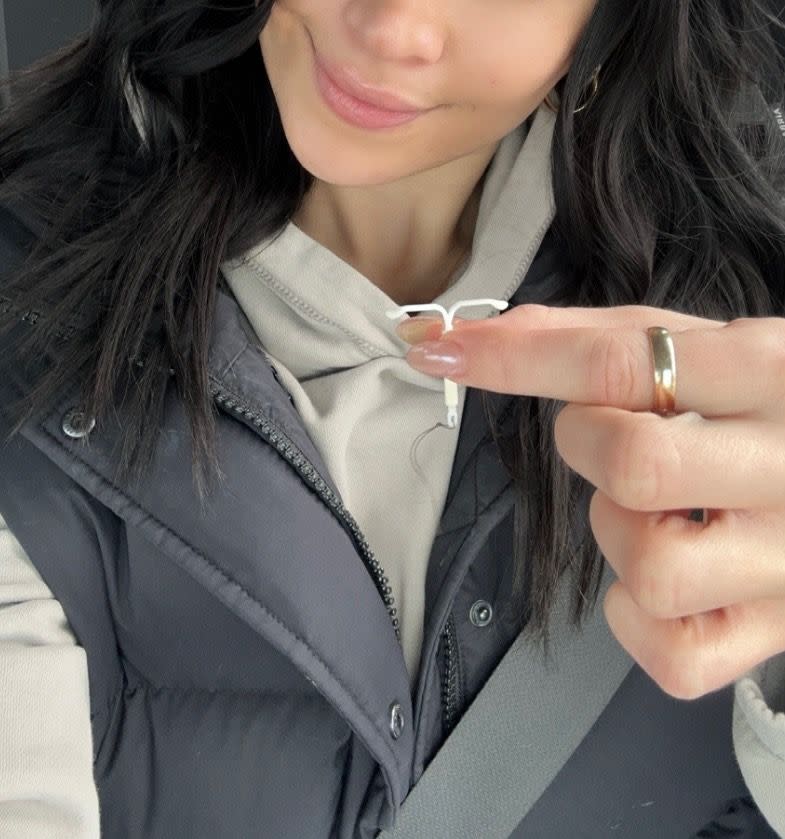'Getting An IUD Was Excruciatingly Painful—Here’s How TikTok Helped Me Cope'
"Hearst Magazines and Yahoo may earn commission or revenue on some items through these links."
I was 17 when I decided to go on birth control for the first time. I was in my first long-term relationship and wanted a reliable, effective form of contraception. I started on the pill, but I was forgetful and never consistent with it (which is crucial for its effectiveness), so my mom suggested an intrauterine device (IUD) thanks to its 99 percent effectiveness at preventing pregnancy.
At the time, I was a senior in high school in a small town in Alberta, Canada, and there was only one doctor at a nearby college clinic that offered IUD insertions every Thursday. Most of my friends got their IUD inserted there, so it seemed like the most convenient option. I booked an appointment for a hormonal IUD.
Prior to my appointment, I had never been to the gynecologist. My primary care provider previously prescribed the pill, but I had never had any sort of pelvic exam. So, not only was I nervous about the IUD procedure itself, which I heard was uncomfortable, but I really had no clue what to expect when I walked into the doctor’s office.
My boyfriend at the time drove me to the appointment, but it was 2021 and COVID-19 restrictions were still in full force, so he couldn’t come inside. Because I was going into the procedure alone, I decided to film my reaction as proof of what I actually went through to show him afterward. I also thought filming would be a distraction since no one was there to hold my hand.
I was never told to take any pain medication ahead of time.
At the start of the appointment, my doctor said I would experience some discomfort and it would likely hurt. I know the pain varies from person to person, but knowing what I know now, she definitely downplayed it. To be honest, though, I don’t think anyone could have described the pain or prepared me for what would come.
First, the doctor inserted a metal speculum, and aside from it feeling awkward and vulnerable, there was no initial pain. However, once my doctor inserted the IUD through the cervix and into my uterus, it was excruciating. I tried to breathe and stay calm, but the stabbing pain felt like it was ripping me apart from the inside out.
It only lasted a few seconds, but there was an issue with the initial insertion process, so my doctor had to re-insert the device, which, again, was unbearably uncomfortable. I basically went through the whole thing twice. Luckily, once the device was in place and the initial throbbing subsided, I felt okay and was able to go home.

My doctor mentioned that I might have light cramping after the insertion, but about an hour later, the cramps became intolerable. I was curled on the bathroom floor, crying, and throwing up from the sharp, intense spasms. It was the worst pain I ever experienced. I took medication in an attempt to ease the symptoms, but the debilitating cramps lasted for hours and I ended up taking a few days off work while I recovered.
Later, I posted a TikTok video of my reaction and quickly realized IUD insertion pain is a common experience that’s rarely talked about.
I never expected my video to reach an audience, but it went viral with millions of views. Thousands of people commented, exchanging stories, asking questions, and unpacking their own experiences. I found solace in connecting with others who could relate. I did my best to respond to the comments and questions, but as the video gained more traction, it was really cool to see other women who went through the same thing jump in and respond to viewers who were curious about the procedure, pain, and overall experience.
After day four, all pain dissipated, and it seemed like things were finally smooth-sailing.
It was great not having to stress about taking a pill or worrying about getting pregnant. I also immediately noticed my periods were practically non-existent, which was a major perk.
That said, every form of hormonal birth control has its pros and cons, and I began to experience severe hormonal acne and mood swings soon after the IUD insertion. My skin was constantly breaking out and I was always anxious, irritable, or moody. My self-confidence tanked and I didn’t mentally feel like myself.

Three years later, I made the decision to get my IUD removed.
The IUD I had is effective for up to eight years, but for me personally, my hormonal acne and mood swings outweighed the pros, and my body needed a break. I wanted to get off hormonal birth control.
So, after three years with my IUD, I decided to have it removed last month. I’ve since moved away from home, so I went to a different clinic and doctor, but the removal process was nothing compared to the insertion—the pain was minimal.
It’s only been a month without my IUD, so it hasn’t been enough time for my hormones to completely re-regulate, but I’ve already noticed improvements to my skin and my general mood has been positive. I’ll re-evaluate my options in a few months, but for now, I’ve decided to completely stay off hormonal birth control.
Knowing what I now know about the insertion, I personally don’t think I could ever get another IUD. I understand that every experience is unique, but I can't bring myself to undergo the pain again.
That said, my hope is to raise awareness about the lack of pain management surrounding the IUD insertion procedure, and to empower women to advocate for their comfort and well-being as it relates to reproductive care. After all, normalizing conversations about women's bodies and reproductive health is so important for creating a supportive and inclusive healthcare environment.
I strongly believe sexual health is a vital component of mental health, and it’s crucial to make informed choices that align with your personal preferences and needs. My advice? Familiarize yourself with the IUD procedure and ask questions. From there, you can discuss pain management options with your doctor to mentally and physically prepare.
You Might Also Like
